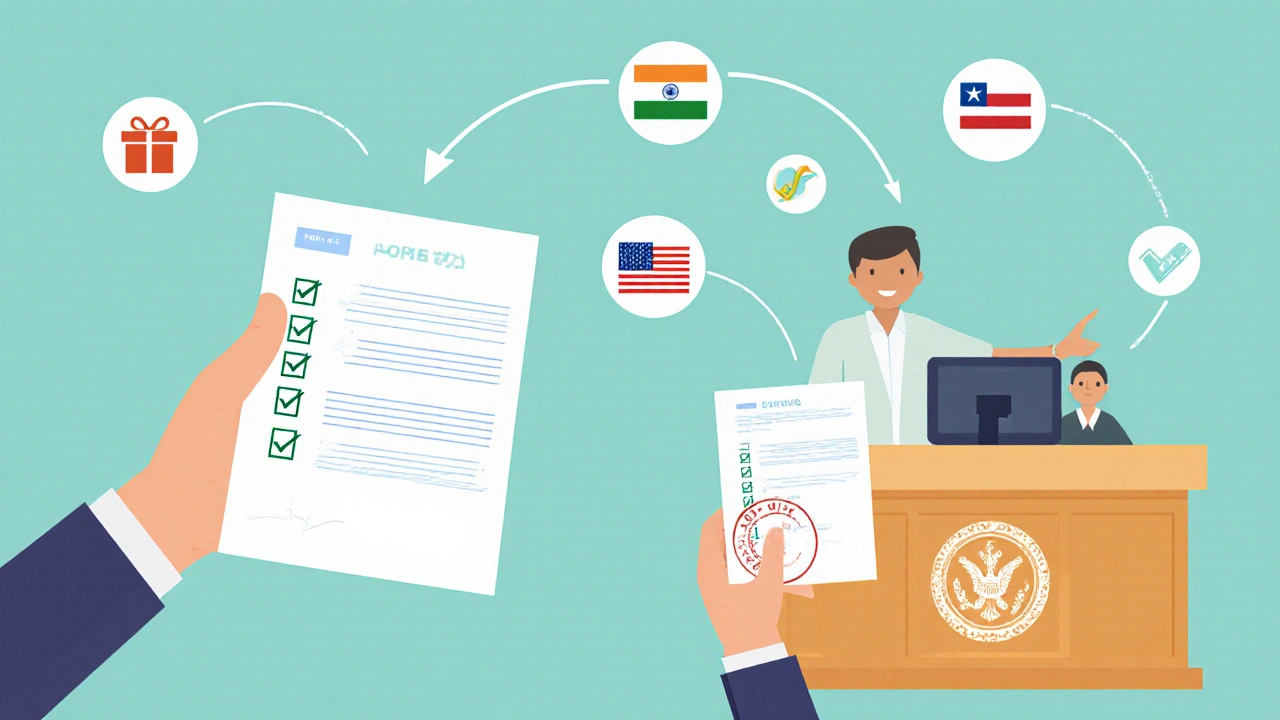 Oct, 11 2025
Oct, 11 2025
LRS Limit Calculator & Compliance Guide
Calculate Your Remaining LRS Limit
Track your annual tax-free transfer limit under FEMA's Liberalised Remittance Scheme (LRS).
Remaining Limit: USD
Compliance Required: Form 15CA and 15CB may be needed for this transfer. Check details below.
Key Remittance Tips
- The LRS limit is USD 250,000 annually (April 1 to March 31)
- All transfers count toward your single limit
- Use NRE accounts for tax-free remittances
- Document your purpose with proper receipts
Thinking about sending cash from India to the United States and wondering how much you can do without triggering a tax bill? You’re not alone. Hundreds of Indians move money abroad each month for tuition, investment, family support, or travel, and the rules can feel like a maze. This guide breaks down the legal ceiling, the paperwork you’ll need, and the common traps that turn a smooth transfer into a costly headache.
Legal framework that governs overseas transfers
Two key statutes shape every cross‑border remittance from India:
- Foreign Exchange Management Act (FEMA) regulates all foreign exchange transactions to protect the country’s reserves.
- Reserve Bank of India (RBI) issues the detailed guidelines that banks must follow for every outward remittance.
Under FEMA, the Liberalised Remittance Scheme (LRS) allows resident individuals to remit a certain amount abroad each financial year for permissible purposes such as education, medical treatment, travel, and investment. The LRS is the backbone of any tax‑free limit discussion, because it sets the ceiling that the government officially permits.
What is the current tax‑free ceiling?
As of the 2024‑25 financial year, the RBI caps the LRS at USD 250,000 per fiscal year (April1toMarch31) for each resident individual. This amount is tax‑free on the Indian side as long as the purpose falls under the RBI‑approved categories and you comply with the required forms.
Important nuance: the ceiling is a *combined* limit across all permissible categories. If you send USD 100,000 for a child’s tuition and USD 150,000 for a property purchase in the U.S., you’ll hit the limit and any further remittance will need special approval or will be considered a foreign investment under different rules.
When does the transfer become taxable?
The LRS limit itself is not a tax shield; it simply tells you how much you can move without breaching foreign‑exchange rules. Whether you owe Indian income tax depends on the nature of the money:
- Gift or personal support: If you’re sending cash as a gift to a family member abroad, the amount is not taxable in India, but the recipient may face U.S. gift‑tax reporting if it exceeds the annual exemption (USD 17,000 in 2025).
- Investment in foreign assets: Capital gains from overseas stocks or mutual funds are taxable in India at the applicable rates (15% for long‑term equity, 30% for short‑term). The principal amount itself isn’t taxed when transferred.
- Loan repayment: If you’re repaying a loan taken abroad, the principal is not taxable, but any interest earned in the U.S. may be taxable in India under the “income from other sources” head.
In short, the tax‑free limit refers to the RBI‑sanctioned amount you can move without breaching foreign‑exchange law. Income tax liability is determined separately based on what you do with that money after it lands in the U.S.

Step‑by‑step compliance checklist
- Determine the exact purpose of the transfer (education, investment, gift, etc.).
- Check that the total amount for the FY stays within the USD 250,000 LRS ceiling.
- Gather supporting documents:
- Admission or fee receipt for education.
- Purchase agreement or invoice for property or investment.
- Letter of intention for a gift, stating the relationship.
- Obtain a chartered accountant’s certificate (Form 15CB) if the remittance exceeds INR 7lakhs and the purpose is not covered under the “payment for goods/services” exemption.
- Fill out Form 15CA online on the Income Tax Department portal - it’s a declaration that the remittance complies with tax laws.
- Submit Forms 15CA/15CB to your bank along with the transfer request.
- Bank will debit your NRE/NRO or regular savings account and route the money through the SWIFT network to the U.S. recipient.
Failure to submit these forms can lead to penalties ranging from 2% to 200% of the transaction amount, plus potential legal action.
Understanding Form 15CA and Form 15CB
These two forms often cause confusion, but their roles are simple:
- Form 15CA is an online self‑declaration that the remitter has complied with the Indian tax laws. It has four parts, and you’ll use Part C or Part D only if a chartered accountant’s certificate is required.
- Form 15CB is the chartered accountant’s certificate. It confirms the nature of the payment, the taxability, and the applicable tax rate (if any). The CA will also reference the relevant provision of the Income Tax Act.
For transfers under INR 7lakhs that are for “gift, donation, or personal expenses,” you can usually file Part A of Form 15CA without a CA certificate.
Common pitfalls and how to avoid them
- Exceeding the USD 250,000 limit: Some people think the limit resets monthly. It’s annual, so keep a running tally across all banks.
- Misclassifying the purpose: Declaring an investment as a gift can attract scrutiny. Always match the purpose with supporting documents.
- Ignoring U.S. reporting rules: Even if India doesn’t tax the gift, the IRS may require Form3520 for foreign gifts over USD 17,000.
- Skipping Form 15CA/15CB: The RBI will reject the transaction, and you may face a penalty for non‑compliance.
- Using the wrong account type: NRE accounts are fully repatriable and tax‑free for interest, while NRO accounts have a 30% TDS on interest and limited repatriation.

Alternatives to LRS for large transfers
If you need to move more than USD 250,000 in a year, consider these routes:
- Foreign Direct Investment (FDI) route: Companies can invest up to USD 1billion under specific approvals.
- External Commercial Borrowings (ECBs): Corporate borrowers can raise overseas debt, subject to RBI caps.
- Non‑Resident Indian (NRI) accounts: Funds already in an NRE/NRO account can be repatriated without affecting the LRS ceiling.
Each alternative has its own compliance checklist and cost structure, so consult a tax advisor before proceeding.
Quick reference table
| Purpose | Maximum under LRS (FY 2024‑25) | Indian Tax Liability | Key Forms |
|---|---|---|---|
| Education fees | USD 250,000 (cumulative) | No tax on principal; interest on any loan is taxable | Form 15CA (Part A), admission proof |
| Medical treatment | USD 250,000 (cumulative) | No tax on principal; any insurance payout is taxable | Form 15CA (Part A), medical invoice |
| Gifts to relatives | USD 250,000 (cumulative) | Not taxable in India; recipient may need IRS Form 3520 | Form 15CA (Part A), relationship declaration |
| Investment in US equity/real estate | USD 250,000 (cumulative) | Capital gains tax as per Indian law (15%‑30%) | Form 15CA (Part C/D), Form 15CB from CA |
| Loan repayment to US lender | USD 250,000 (cumulative) | Principal non‑taxable; interest taxable as “income from other sources” | Form 15CA (Part A), loan agreement |
Next steps for a smooth remittance
1. Calculate your total FY usage - add up every outbound payment you’ve already made. 2. Gather the required documents for the intended purpose. 3. Book an appointment with your bank’s foreign‑exchange desk and ask for the LRS‑remittance form. 4. Complete Form 15CA online; if the amount exceeds INR 7lakhs, get a Form 15CB from a chartered accountant. 5. Submit the paperwork, confirm the SWIFT code of the U.S. beneficiary, and keep the transaction receipt for your records.
Staying within the LRS limit and filing the right forms eliminates the risk of penalties, freezes, or a nasty surprise from the tax department.
Frequently Asked Questions
Can I send money to my U.S. spouse without tax implications?
Yes, a transfer to a spouse is considered a personal remittance. As long as the total stays under the USD 250,000 LRS ceiling, there’s no Indian tax on the principal. Your spouse may need to report the gift to the IRS if it exceeds the U.S. annual exemption.
Do I need to file Form 15CA for every single transfer?
Form 15CA must be filed for each outward remittance. Small gifts under INR 7lakhs can use Part A (self‑declaration). Larger or non‑gift payments require Part C or Part D along with a CA‑certified Form 15CB.
What happens if I exceed the USD 250,000 limit?
Exceeding the LRS limit triggers RBI scrutiny. The excess amount will be rejected unless you obtain a special permission under the Foreign Direct Investment route or similar. Repeated violations can attract penalties up to 200% of the transaction value.
Is the USD 250,000 limit per bank or per individual?
The limit is per resident individual for the entire financial year, regardless of how many banks you use. All outbound remittances count toward the same ceiling.
Do I need to report the transfer to the Indian Income Tax Department?
Form 15CA/15CB serve as the statutory report. Additionally, you must disclose the remittance in your annual income tax return under Schedule C (Foreign Assets). Failure to do so can lead to penalties.